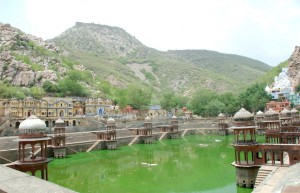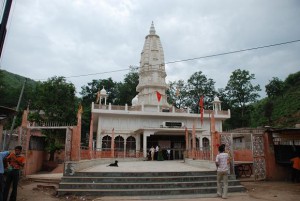Tourist Attraction Of Alwar

The Alwar fort, built on a hill, about 1960 feetabove the sea level, stands majestically 1000 feet above the city of Alwar. The fort was built by Hasan Khan Mewati in 1550 A.D. It passed from the Mughals, to the Marathas, to the Jats, till it was finally captured by the Kachhwaha Rajputs. The fort, from nort to south is about 5 kms. long and is about 1.5 kms. wide. There are six entrances to the fort which are, Chand Pol, Suraj Pal (named after Raja Suraj Mal of Bharatpur), Jai Pol, Kishan Pol, Andheri Gate and Laxman Pol. It is said that PratapSingh, the founder of Alwar state used Laxman Pol for entering the fort forth first time. Ametalled road in th past connected the city with Laxman Pol.

The ruins of Bhangarh paint a picture of the ancient The ruins of Bhangarh paint a picture of the ancient kingdom that once flourished here. Founded in 1631 by Madho Singh, Younger brother of th famous Man Singh of Amer, this town of about 10,000 dwellings was suddenly abandoned due to reasons clothed in mystery. Particularly noteworthy is the town plannng, castle hierarchy, market system and the charming beauty of several temples.
Bhartrihari
A throubbing pilgrimage centre which revolvesaround the legend of King Bharathari who wandered about in exile. In this region in panance for his suspicions against his younger brother Vikramaditya (renowned king of Malwa).

A chhatri built in memory of Moosi Rani, wife of Maharaja Bakhtawar Singh, is magnificent. It took nine years(1804 A.D. to 1813 A.D.) to complete the construction of the tank.

Below the scarred battlements of the fort,at the base of the hill across which it sprawls, is the City Palace with its spacious apartments. This now houses a museum within it with its collection of royal memorabilia. An exquisite pond called Sagar is situated behind the City Palace.

Sariska Place built in 1892 – 1900 as a hunting camp by the erstwhile ruler of the Alwar is now a luxury hotel. Sariska is open to visitors throughout the year but the best season to observe wildlife is during winter months. i.e. from November to March. The Rajasthan Tourism Dev. Corpn. runs a hotel and also provides transport on hire to visit the sanctuary.

Ancient Jain temple dedicate to the eighth Tirthankar (great teacher) Shri Chandra Prabhu Bhagwan can be seen here. It has elaborate carvings and paintings, exquisite pillars and arches. Situated 60 kms. on the Alwar – Delhi road route, it is an important Jain pilgrimage. Loading fooding facility is available.

A diversion of 10km from Kushalgarh ( on Sarishka – Alwar road) and 35 km from Alwar takes one to this enchanting site where pilgrims bathe in hot spring. Langoors (apes) stroll about and the bells of the scattered temples tinkle all day long. It was the place of penance of Mandav Rishi.

The palace Museum has a wonderful collection of exhibits of the personal wealth of the Maharajas of Alwar section which has some historic swords belonging to the likes of Sultan Muhammed Ghori, emperors Akbar and Aurangzeb.

On the main road between Delhi-Jaipur, this Chauhan stronghold nestles in a horseshoe-shaped cleft in the hills. The fort, built over different periods of its history, is picturesque, and has recently been restored. Now a heritage hotel, it is the perfect base to visit the deep stepwells within walking distance that can be explored on foot.

An arduous, bumpy drive of 8 Kms. taking off from Tehla Village is very well compensatd by an overwhelming view of ruins of several ten centuries old, fabulously carved temple which stand studded on a small hillock surrounded on all sides by forest covered hills. Particularly remarkable is the highly venerated Shiva temple where worship is done even today and the single stone giant structure of 23rd Jain Tirthankar locally known as “Nogaza”.

A trip through the sanctuary forest follows the trail of th Pandava brothers to a rock-wall through which the strong Bhim created a passage for their escape from the Kauravas. This forested glen has a narrow stream and deep waterholes. Temples here draw pilgrims round the year, though it is most popular during a September fair.

Behind the city place and just below the fort is a beautiful tank locally known as Sagar. It is very picturesque during the rainy season. The tank has a flight of steps leading to its bottom and is surrounded by 12 chhatries or cenotaphs built of red marble slabs.

The Sariska Tiger Reserve is just 40 kms. from Alwar and about 110 kms. from Jaipur. The landscape of Sariska is dominated b thickly forested hill slopes with vertical cliffs. The terrain is basicall undulating with some wide plateau lands separating the valleys. This game sanctuary southwest of Alwar was once the personal hunting ground of the Maharajas of Alwar. I become a sanctuary in 1955 and aws later taken up under Project Tiger in 1979. It covers an area of 320 sq.miles. The forested hills of Sariska are among the best places to view tigers in India. Leopared, Hyena, Somebar, Nilgai, Chinkara, Chansingha, Sp.of Monkey, Birds are other attractions.

Enroute to Sariska, 12 Kms. South west of Alwar is the water places of Siliserh with a lake surrounded by low, wooded hills, Now a Rajathan Tourism (RTDC) Hotel. The lake was built in 1845 A.D. by constructing an earthern dam between two hills to store the water of a small tributary of river Ruparel. When full, the total water spread covers an area of about 10 sq. kms. Adorned with domed cenotaphs, Siliserh lake is picturesquely set amidst the forested slopes of Aravalli hills. The open terraces of theSiliserth Palace provide a breathtaking view of the water spread of the lake and its surrounding environment. This tetefully built old palace is now converted into a tourist hotel and is managed by the Rajasthan Tourism Development Corporation. The basement of this four storied palace leads to the water level of the lake. A boat trip in the lake, particularly during winter season, is a rewarding experience.

